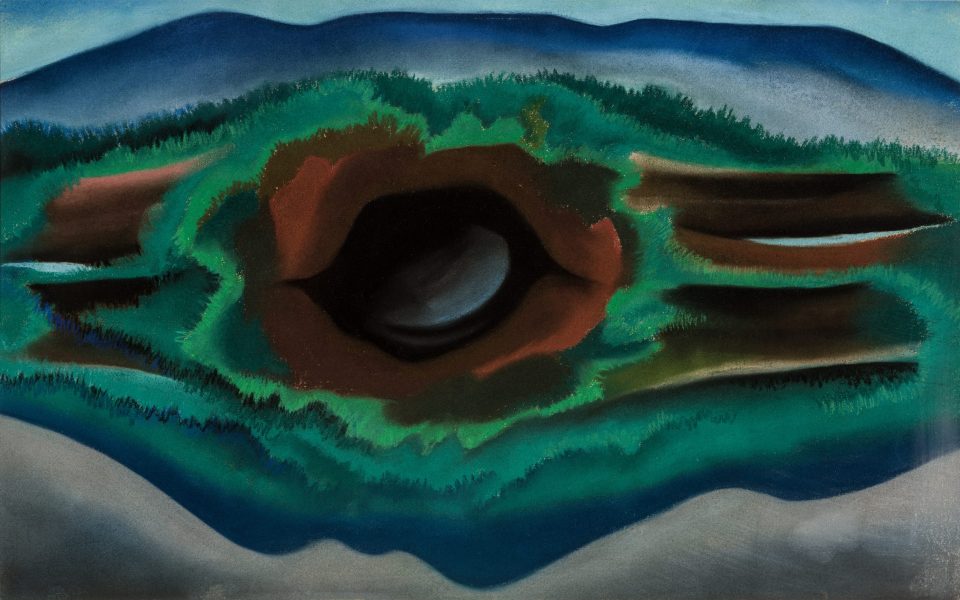From walls filled with early abstract watercolors to displays of handmade clothes O’Keeffe designed and wore, the gallery at Reynolda House has brought the inner mind and life of the artist into the public’s consciousness.
“It suddenly became more than just the art,” curator Allison Slaby said. “When I spoke with Wanda Corn, she quickly saw that O’Keeffe was more than just her art, she was living and breathing the very art she made. Her life was formed around it. She, quite literally, lived what she created.”
The exhibit became a tribute and homage to the life of the artist. Expanding from the main gallery and into several rooms of the historic Reynolda House, the Georgia O’Keeffe: Living Modern exhibit has displaced several staff from their offices to make room for it. Since the exhibit opened in early August, the staff and business side of the museum were forced to make a few changes, including Slaby, whose office now temporarily resides in the private kitchen of the historic Reynolda Museum.
“This exhibit has been just awe-ing,” Slaby said in her office. “My office is actually on the upper level, but because of the size of the exhibit, we needed make as much room as we could. And I’m starting to like this new set-up.”
Since Brooklyn Museum curator Wanda Corn first conceived of the O’Keeffe exhibit, Reynolda House quickly became involved.
“Wanda Corn initially contacted us to use our original O’Keeffe [painting], ‘Pool in the Woods,’” Slaby said. “And in exchange for that, we managed to bring the exhibit to Winston-Salem. It’s been amazing to be a part of this. We have seen some of the highest attendance numbers ever since the opening. We feel honored to be able to bring this to our community.”
The Georgia O’Keeffe Living Modern exhibit spans five rooms of Reynolda. The main gallery walks guests through O’Keeffe’s humble, tenuous beginnings to the pinnacle of her career as an artist, designer and sculptor. Going beyond the initial ideas of building a gallery of O’Keeffe’s artwork alone, a new theme developed as curators teamed up and combed through the artist’s work.
Moving about the exhibit, the arc of O’Keeffe’s long career is apparent. The struggle of being one of the first prominent female artists bursts forth from each display, from every photograph.[pullquote]The Georgia O’Keeffe gallery runs until Nov. 19. For tickets and information, visit
reynoldahouse.org.[/pullquote]
One moment representative of O’Keeffe coming into her in New York art world can be seen in her massive work “Manhattan.” For an exhibition at the Museum of Modern Art in 1932, O’Keeffe was among 60 contemporary artists commissioned to create art for a public mural. O’Keeffe’s contribution was a triptych of modern New York City. In doing so, she claimed a subject that had long been the stomping ground of male artists. “Manhattan” shows a jaggedly abstract vision of a cityscape, moving from dark browns and blues on the edges to a center bursting with soft reds, mauves and little flowers blooming.
Pool in the Woods, Lake George, the O’Keeffe painting in Reynolda’s permanent collection, is one of the artist’s lesser known works. The painting merges O’Keeffe’s famous technique of blending the difficult and challenging line of the abstract with realism. Pool in the Woods features what O’Keeffe called the “dash and go” technique that she learned as an understudy to William Merritt Chase. The short, dashing bursts of color and brush strokes were a style O’Keeffe would master and use throughout her career. The dark, heavy use of color throbs with emotion and a swelling effect the pulses forth from the canvas. Though the painting was overshadowed by photographs and other paintings at its original exhibit in 1923, Pool in the Woods marked O’Keeffe as a powerful new artist, and remains an integral feature in her life’s work, according to critics.
“Guests have truly been changed after seeing the exhibit,” Slaby said. “From pure ecstasy to bursting into tears, it’s shows us the power of art, the power of the artist in our world.”
Join the First Amendment Society, a membership that goes directly to funding TCB‘s newsroom.
We believe that reporting can save the world.
The TCB First Amendment Society recognizes the vital role of a free, unfettered press with a bundling of local experiences designed to build community, and unique engagements with our newsroom that will help you understand, and shape, local journalism’s critical role in uplifting the people in our cities.
All revenue goes directly into the newsroom as reporters’ salaries and freelance commissions.


Leave a Reply